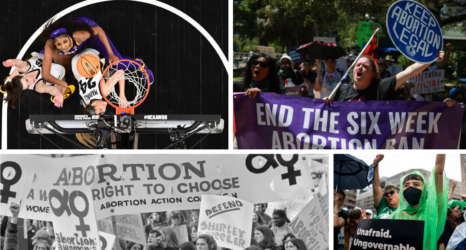Divorced and never-married women must make common cause and demand public policies—from universal childcare to Social Security credits for caregiving labor in the home—that recognize care work as the valuable and essential labor it is.

Together, divorce and economic dependence spell economic crisis for women. In the COVID-19 recession, that crisis is a looming reality for many.
Women are losing jobs at a disproportionate rate, and experts are predicting a wave of divorces. As women are forced out of the workforce to care for children whose schools and daycares are closed, married women’s economic dependence on their husbands is only growing.
Put differently, the pandemic is undoing decades of progress, reinforcing a breadwinner-homemaker division of labor for all too many women. When rising divorce rates get added to the mix, history teaches us the combination can be volatile.
The Work of Divorced Feminists in the 1970s Remains Unfinished
In the 1970s and 1980s, feminist activists organized around the economic crises divorced women experienced. They demanded social policies that protected women by expanding access to public goods and recognizing the value of carework.
At times divorced feminists collaborated with other single women to demand policies that helped all women access resources like health care; at other times divorced women and never-married women ended up on opposite sides of policy debates about those same resources.
In the end, the reforms they won represented significant compromises that leave all women vulnerable in our current moment and much work to be done.
In my forthcoming book, Divorce, American Style, I explore the last sharp spike in the divorce rates—in the 1970s—and how newly divorced women’s discovery of their economic vulnerability drove a political movement for transitional justice.
Many of the women getting divorced in the 1970s had been out of the workforce for years, caring for families while their husbands supported them because that was the social expectation when they married. They successfully claimed that they were victims of a world that had changed around them, and on the strength of that narrative, won new access to economic resources.
Their movement couldn’t last long, because as married women moved into the workforce in greater numbers, that claim lost resonance.
Today, as the pandemic pushes women back out of the workforce, it is clearer than ever that the work of divorced feminists in the 1970s remains unfinished.
When feminists started organizing around divorce, only 40 percent of married women were in the workforce. Even those women who were employed outside the home were relatively unlikely to have access to their own health insurance or retirement pensions.
Yet, when a couple divorced in 1970, the chances of a woman receiving alimony were less than 20 percent. In addition to losing the income she had received through her husband, a divorcing woman promptly lost access to any health insurance she had accessed through her husband’s employer.
Similarly, unless she had been married for 20 years, a divorcing woman lost the Social Security she would have drawn through her husband upon his retirement. Public policies assumed that when a marriage ended, spouses’ economic entanglement should end, but they did not anticipate that this could impoverish women who had been out of the workforce for years.
Today, Married Women See Only Minimal Improvements Over the Status Quo in 1970
Today, things are only a little better. Far more married women are now in the workforce. If your marriage has lasted 10 years, you are eligible to receive half of the amount your spouse receives through Social Security when he/she retires.
In addition, through COBRA, you can pay to maintain access to the health insurance you received through your spouse, though you have to pay both the employer and employee premiums. If you are lucky enough to have a spouse with private retirement savings, a judge might divide them in a divorce if your lawyer makes a good case (the law clearly allows for such division).
If these strike you as rather minimal improvements over the status quo in 1970, you are not wrong. For those who rely on their spouses’ income, health and retirement benefits, these protections leave access to essential economic resources after divorce expensive and limited.
Yet these protections are the result of 15 years of sustained activism by divorced women. These women started out with a broad agenda demanding legislation that would decouple access to economic resources from marriage. They called for national health insurance and Social Security credits for women who did unpaid care work in the home. If they had succeeded in winning these more universal kinds of public goods, women today would be far more secure.
What happened to this broader agenda? Feminist advocates ran into intense opposition from the insurance industry, anti-feminists led by Phyllis Schlafly, and conservatives who did not want to expand the welfare state (three highly overlapping groups).
They also ran into policymakers’ deep attachment to the breadwinner-homemaker model of marriage. Congress was even willing to spend extra to subsidize breadwinner-homemaker-style marriages, to avoid offering each individual their own Social Security account based on joint earnings.
Because they further entrenched the breadwinner-dependent model of marriage into legislation, the compromises struck by feminists in the 1970s and 1980s were particularly damaging to never-married women. Ironically, this was a growing demographic group; the marriage rate has fallen consistently since the 1980s.
Had feminists’ original agenda won the day—broadening access to public goods while forcing public policy to recognize the value of care work—all women would have benefited. Instead, the compromise legislation feminists won means that today, single women who never married have fewer options for accessing economic resources than single women who were once married.
Pandemic Exacerbates Financial Distress of Divorce
In this pandemic, married parents who have had to leave the workforce to take on childcare are luckier than their single counterparts, who have lost jobs at a higher rate than married mothers but don’t have a spouse to help supplement their earnings. And, even if they ultimately divorce, these spouses will have economic protections that single parents who never married do not.
But, as we have seen, these are limited protections. As the pandemic drives a return to deeper financial inequality within marriages, these protections will do little to keep women out of financial distress if their marriages end.
The unfinished business of divorced feminists who fought for broader public goods is once again pressing.
In the 1970s and 1980s, divorced feminists agreed to compromises that benefited only divorced women and created two different classes of single women.
This time around, divorced women and never-married women must make common cause and demand public policies—from universal childcare to Social Security credits for caregiving labor in the home—that recognize care work as the valuable and essential labor it is.
You may also like:





